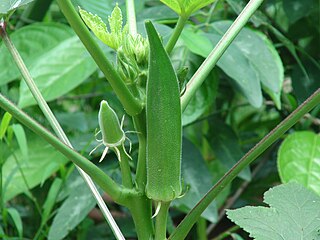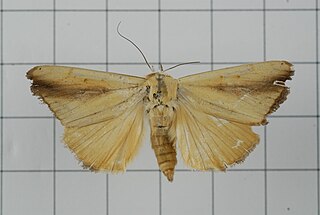Mallow or mallows may refer to:

Hibiscus is a genus of flowering plants in the mallow family, Malvaceae. The genus is quite large, comprising several hundred species that are native to warm temperate, subtropical and tropical regions throughout the world. Member species are renowned for their large, showy flowers and those species are commonly known simply as "hibiscus", or less widely known as rose mallow.

Malvaceae, or the mallows, is a family of flowering plants estimated to contain 244 genera with 4225 known species. Well-known members of economic importance include okra, cotton, cacao, roselle and durian. There are also some genera containing familiar ornamentals, such as Alcea (hollyhock), Malva (mallow), and Tilia. The genera with the largest numbers of species include Hibiscus, Pavonia, Sida, Ayenia, Dombeya, and Sterculia.

Okra, Abelmoschus esculentus, known in some English-speaking countries as lady's fingers, is a flowering plant in the mallow family native to East Africa. It has edible green seed pods. Cultivated in tropical, subtropical, and warm temperate regions around the world, okra is used in the cuisines of many countries.

Abelmoschus is a genus of about fifteen species of flowering plants in the mallow family (Malvaceae), native to tropical Africa, Asia and northern Australia. It was formerly included within Hibiscus, but is now classified as a distinct genus. The genus name derives from Arabic meaning 'father of musk' or 'source of musk' referring to the scented seeds.
Neri or Néri may refer to:
Delele is a Zimbabwean, Zambian, north-eastern Botswana and Northern South African dish made from a local plant of the same name, and often eaten with sadza or phaletšhe or Vhuswa. The English word for delele is okra. Okra is also referred to as "derere". It is prepared with baking soda and well known for its slimy texture. Delele can be dried before cooking, but more frequently it is cooked fresh.

Abelmoschus manihot, commonly known as aibika, is a flowering plant in the family Malvaceae. It is a tropical subshrub or shrub native to the Indian subcontinent, Indochina, central and southern China, Malesia, New Guinea, and Queensland. It is cultivated and eaten as a leaf vegetable, among other uses. It was previously classified as a species of Hibiscus but is now categorized under the genus Abelmoschus. This plant is also referred to as the sunset muskmallow, sunset hibiscus, or hibiscus manihot.

Abelmoschus moschatus is an aromatic and species of medicinal plant in the family Malvaceae native to Asia and Australia. It has many common names, including Abelmosk, ambrette, annual hibiscus, Bamia Moschata, Galu Gasturi, muskdana, musk mallow, musk okra, ornamental okra, rose mallow, tropical jewel hibiscus, and Yorka okra.
Abelmoschus caillei, the West African okra, is a plant species in the family Malvaceae. It occurs in humid areas of West and Central Africa, where it is used as a vegetable. It originated as an allopolyploid hybrid of Abelmoschus esculentus and A. manihot, and is often mistaken for either of those two plants. It was officially described elevated to the status of a species in 1988. The same hybrid was produced experimentally in Japan where it is known as Abelmoschus glutino-textile.
Musk mallow or musk-mallow may refer to the following plants from the family Malvaceae:
Rose mallow may refer to:
Native rosella may refer to certain plant species in the family Malvaceae:

Dysdercus cingulatus is a species of true bug in the family Pyrrhocoridae, commonly known as the red cotton stainer. It is a serious pest of cotton crops, the adults and older nymphs feeding on the emerging bolls and the cotton seeds as they mature, transmitting cotton-staining fungi as they do so.

Xanthodes transversa, the transverse moth or hibiscus caterpillar, is a moth of the family Nolidae. The species was first described by Achille Guenée in 1852. It is found in India, Sri Lanka, the Andaman Islands, the Nicobar Islands, China, Hong Kong, Vanuatu, Java, New Guinea, Japan, the Ryukyu Islands, Singapore, Indonesia and Australia.

Xanthodes intersepta is a moth of the family Nolidae first described by Achille Guenée in 1852. It is found in India, Sri Lanka, Myanmar, China, Hong Kong, Japan, the Ryukyu Islands, the Philippines, Indonesia and Java.
Earias fabia, called the cotton spotted bollworm as a larva, is a moth of the family Nolidae. The species was first described by Caspar Stoll in 1781. It is sometimes included in the species Earias vittella.
Yézoumi Akogo is an agricultural scientist from Togo, who attended the National University of Benin. Her research examines the in vitro propagation of plants utilised in market gardening, tubers and medicinal plants. In 2000, she was awarded a L’Oréal-UNESCO Women in Science Fellowship, which enables recipients to fund field research. Akogo has worked on the in vitro propagation of okra, as well as models for experimental plant morphogenesis.

Nisotra is a genus of flea beetles in the family Chrysomelidae. They are found in Africa, Asia, and Australia. There are around 90 described species in Nisotra, including about 70 in Sub-Saharan Africa and Madagascar. Many of these species are agricultural pests.









